纽马克 翻译教程
纽马克的翻译理论

03
有利于目标语读者理解和感受原文的文化背景和内涵
语义翻译的优缺点
语义翻译的优缺点
01
缺点
02
可能过于强调原文的语义和句法结构,导致 目标语表达不够流畅自然
03
可能过于依赖直译,导致译文失去原文的语 言魅力和文化特色
04
可能过于追求准确性和忠实性,忽略译文的 读者感受和文化差异
要点三
文本类型分析
根据纽马克的翻译理论,译者需要对 原文的文本类型进行分析,根据不同 的文本类型采取不同的翻译策略。例 如,在信息型文本中,译者应注重信 息的准确性和清晰度;在号召型文本 中,译者应注重语言的感染力和说服 力。
在机器翻译中的应用
01
语义理解
纽马克的翻译理论强调语义理解在翻译中的重要性。在机 器翻译中,语义理解是关键,机器需要通过对语言的分析 和理解来生成准确的译文。
THANKS FOR WATCHING
感谢您的观看
在实际翻译过程中,语义翻译和交际翻译并不是互斥的, 而是可以相互补充的。在某些情况下,可以将两种方法结 合使用,以达到更好的翻译效果。
无论是语义翻译还是交际翻译,都需要译者具备扎实的语 言基础、文化背景知识和专业素养,以确保翻译的质量和 准确性。
定义与特点
01
02
定义:语义翻译是指根 据原文的语义、句法结 构和表达方式,使用目 标语的对应词汇和结构 进行翻译,尽可能准确 地传达原文的意义和信 息。
可能牺牲原文的艺术性
在文学作品的翻译中,交际翻译可能过于注重信息的传递而牺牲原文的艺术性和审美价值。
文化因素难以完全传递
由于文化差异的存在,交际翻译在传递原文文化因素时可能会遇到困难,难以完全准确地传递文化信 息。
简述纽马克的语义翻译和交 际翻译及其对汉英语篇翻译的 影响
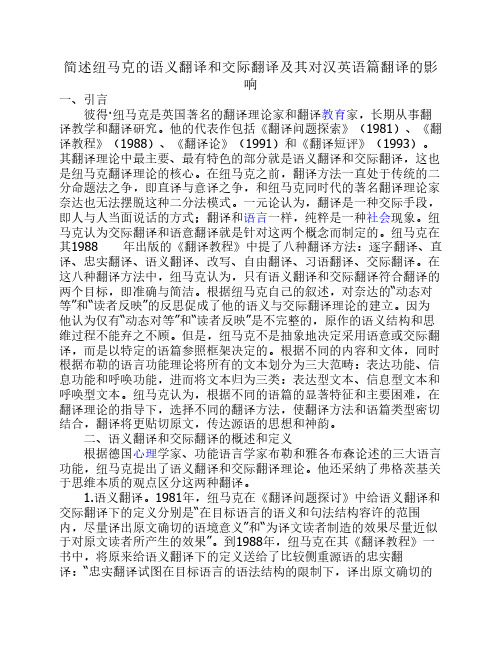
简述纽马克的语义翻译和交际翻译及其对汉英语篇翻译的影响一、引言 彼得·纽马克是英国著名的翻译理论家和翻译教育家,长期从事翻译教学和翻译研究。
他的代表作包括《翻译问题探索》(1981)、《翻译教程》(1988)、《翻译论》(1991)和《翻译短评》(1993)。
其翻译理论中最主要、最有特色的部分就是语义翻译和交际翻译,这也是纽马克翻译理论的核心。
在纽马克之前,翻译方法一直处于传统的二分命题法之争,即直译与意译之争,和纽马克同时代的著名翻译理论家奈达也无法摆脱这种二分法模式。
一元论认为,翻译是一种交际手段,即人与人当面说话的方式;翻译和语言一样,纯粹是一种社会现象。
纽马克认为交际翻译和语意翻译就是针对这两个概念而制定的。
纽马克在其1988 年出版的《翻译教程》中提了八种翻译方法:逐字翻译、直译、忠实翻译、语义翻译、改写、自由翻译、习语翻译、交际翻译。
在这八种翻译方法中,纽马克认为,只有语义翻译和交际翻译符合翻译的两个目标,即准确与简洁。
根据纽马克自己的叙述,对奈达的“动态对等”和“读者反映”的反思促成了他的语义与交际翻译理论的建立。
因为他认为仅有“动态对等”和“读者反映”是不完整的,原作的语义结构和思维过程不能弃之不顾。
但是,纽马克不是抽象地决定采用语意或交际翻译,而是以特定的语篇参照框架决定的。
根据不同的内容和文体,同时根据布勒的语言功能理论将所有的文本划分为三大范畴:表达功能、信息功能和呼唤功能,进而将文本归为三类:表达型文本、信息型文本和呼唤型文本。
纽马克认为,根据不同的语篇的显著特征和主要困难,在翻译理论的指导下,选择不同的翻译方法,使翻译方法和语篇类型密切结合,翻译将更贴切原文,传达源语的思想和神韵。
二、语义翻译和交际翻译的概述和定义 根据德国心理学家、功能语言学家布勒和雅各布森论述的三大语言功能,纽马克提出了语义翻译和交际翻译理论。
他还采纳了弗格茨基关于思维本质的观点区分这两种翻译。
纽马克的翻译类型学
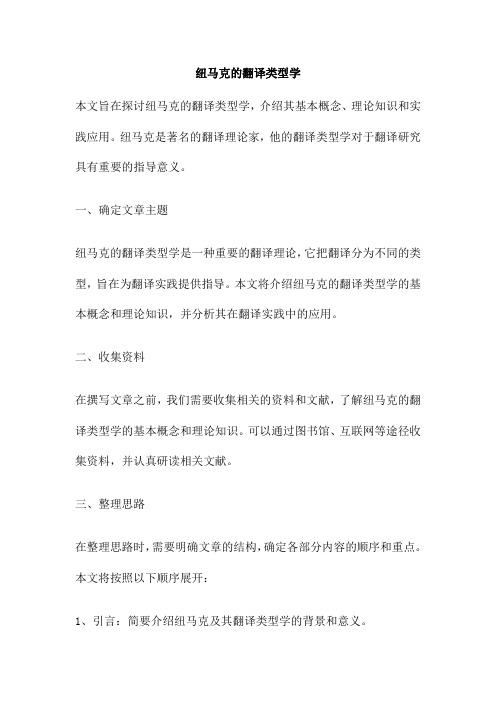
纽马克的翻译类型学本文旨在探讨纽马克的翻译类型学,介绍其基本概念、理论知识和实践应用。
纽马克是著名的翻译理论家,他的翻译类型学对于翻译研究具有重要的指导意义。
一、确定文章主题纽马克的翻译类型学是一种重要的翻译理论,它把翻译分为不同的类型,旨在为翻译实践提供指导。
本文将介绍纽马克的翻译类型学的基本概念和理论知识,并分析其在翻译实践中的应用。
二、收集资料在撰写文章之前,我们需要收集相关的资料和文献,了解纽马克的翻译类型学的基本概念和理论知识。
可以通过图书馆、互联网等途径收集资料,并认真研读相关文献。
三、整理思路在整理思路时,需要明确文章的结构,确定各部分内容的顺序和重点。
本文将按照以下顺序展开:1、引言:简要介绍纽马克及其翻译类型学的背景和意义。
2、纽马克的翻译类型学介绍:详细阐述纽马克的翻译类型学理论,包括翻译类型的划分原则和各种类型的翻译特点。
3、实例分析:通过具体实例分析,说明纽马克的翻译类型学在翻译实践中的应用。
4、总结:对纽马克的翻译类型学进行总结和评价,并指出其局限性。
四、编写大纲根据上述思路,可以编写以下大纲:I.引言 A.介绍纽马克及其翻译理论背景 B.阐述翻译类型学的重要性和应用价值 II.纽马克的翻译类型学介绍 A.翻译类型的划分原则1、字面翻译和解释性翻译2、语义翻译和交际翻译 B.各种类型的翻译特点3、字面翻译的特点4、解释性翻译的特点5、语义翻译的特点6、交际翻译的特点 III.实例分析 A.字面翻译实例分析 B.解释性翻译实例分析 C.语义翻译实例分析 D.交际翻译实例分析 IV.总结 A.总结纽马克的翻译类型学的优点和局限性 B.对未来翻译研究的启示和建议五、撰写文章在撰写文章时,要注意语言流畅、表达清晰,并且要注意逻辑严密和结构合理。
按照大纲的顺序展开,对每个部分进行详细的论述。
在每个部分中,可以通过引用相关文献、列举实例等方式来支持论述。
同时,要保持各部分内容之间的衔接和连贯性。
纽马克论交际翻译与语义翻译

纽马克论交际翻译与语义翻译一、本文概述《纽马克论交际翻译与语义翻译》这篇文章主要探讨了纽马克提出的两种翻译方法:交际翻译和语义翻译。
纽马克是20世纪著名的翻译理论家和实践家,他在其著作《翻译问题探讨》中详细阐述了这两种翻译方法的核心思想和应用。
本文旨在概述纽马克的交际翻译与语义翻译理论,分析它们的定义、特点、应用及其在翻译实践中的意义。
本文将介绍纽马克的翻译理论背景及其在翻译领域的贡献。
然后,详细阐述交际翻译和语义翻译的定义和特点,包括它们的区别和联系。
接着,通过具体案例分析,探讨这两种翻译方法在实际翻译过程中的应用,以及它们在处理不同文本类型和语言风格时的优势和局限性。
总结纽马克的交际翻译与语义翻译理论对翻译实践和翻译研究的启示和影响。
通过对纽马克的交际翻译与语义翻译理论的深入剖析,本文旨在帮助读者更好地理解这两种翻译方法的内涵和应用,提高翻译实践的质量和效率。
本文也旨在为翻译研究和教学提供有益的参考和启示,推动翻译学科的发展和进步。
二、交际翻译与语义翻译的定义与特点纽马克(Nida)的交际翻译和语义翻译理论是翻译研究中的重要理论之一。
这两种翻译方法各有其独特的定义和特点,对于理解和处理不同类型的文本具有重要的指导意义。
交际翻译,顾名思义,强调的是翻译过程中的交际效果。
纽马克认为,交际翻译的主要目标是使译文读者能够像原文读者一样理解和欣赏原文,即实现原文的交际功能。
因此,在交际翻译中,译者需要充分考虑到译文读者的文化背景、语言习惯等因素,对原文进行适当的调整和改写,以确保译文的流畅性和自然性。
这种翻译方法通常适用于那些以信息传递为主要功能的文本,如新闻报道、科技论文、广告等。
与交际翻译不同,语义翻译则更加注重原文的语义内容和形式。
纽马克认为,语义翻译的主要目标是尽可能保留原文的语义信息,包括词汇、语法、修辞等方面的特点。
在语义翻译中,译者需要尽可能准确地传达原文的语义内涵,而不是追求译文的流畅性和自然性。
纽马克的翻译理论主要是什么
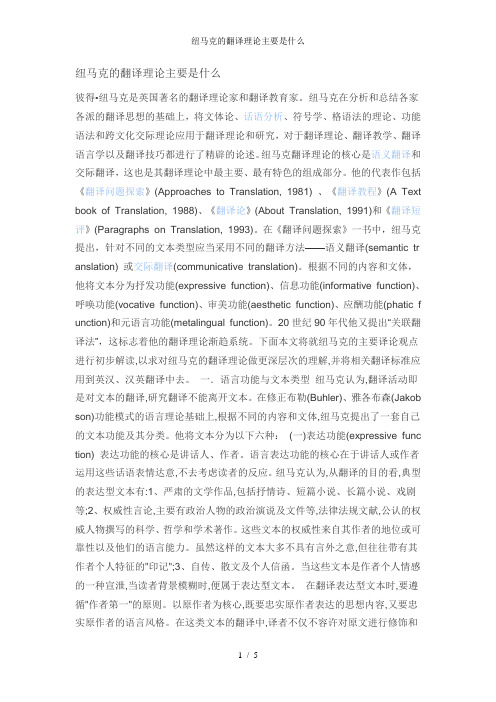
纽马克的翻译理论主要是什么彼得•纽马克是英国著名的翻译理论家和翻译教育家。
纽马克在分析和总结各家各派的翻译思想的基础上,将文体论、话语分析、符号学、格语法的理论、功能语法和跨文化交际理论应用于翻译理论和研究,对于翻译理论、翻译教学、翻译语言学以及翻译技巧都进行了精辟的论述。
纽马克翻译理论的核心是语义翻译和交际翻译,这也是其翻译理论中最主要、最有特色的组成部分。
他的代表作包括《翻译问题探索》(Approaches to Translation, 1981) 、《翻译教程》(A Text book of Translation, 1988)、《翻译论》(About Translation, 1991)和《翻译短评》(Paragraphs on Translation, 1993)。
在《翻译问题探索》一书中,纽马克提出,针对不同的文本类型应当采用不同的翻译方法——语义翻译(semantic tr anslation) 或交际翻译(communicative translation)。
根据不同的内容和文体,他将文本分为抒发功能(expressive function)、信息功能(informative function)、呼唤功能(vocative function)、审美功能(aesthetic function)、应酬功能(phatic f unction)和元语言功能(metalingual function)。
20世纪90年代他又提出“关联翻译法”,这标志着他的翻译理论渐趋系统。
下面本文将就纽马克的主要译论观点进行初步解读,以求对纽马克的翻译理论做更深层次的理解,并将相关翻译标准应用到英汉、汉英翻译中去。
一.语言功能与文本类型纽马克认为,翻译活动即是对文本的翻译,研究翻译不能离开文本。
在修正布勒(Buhler)、雅各布森(Jakob son)功能模式的语言理论基础上,根据不同的内容和文体,纽马克提出了一套自己的文本功能及其分类。
THE METHODS 方法论(纽马克《翻译教程》第五章)

THE METHODS 方法论Word-for-word translation逐字翻译This is often demonstrated as interliner translation, with the TL immediately below the SL words. The SL word-order is preserved and the words translated singly by their most common meanings, out of context. Cultural words are translated literally. The main use of word-for-word translation is either to understand the mechanics of the source language or to construe a difficult text as a pre-translation process.其通常的表现形式为行间翻译,即将目的语直接标在源语的下方。
源语语序会予以保留,每个词译出其最常见的意思。
文化性词语只作字面翻译。
逐字翻译的主要作用或是帮助理解源语句子结构,或是作为翻译前的一个过程,用来分析解释一个较难的文本。
Literal translation直译The SL grammatical constructions are converted to their nearest TL equivalents but the lexical words are again translated singly, out of context. As a pre-translation process, this indicates the problems to be solved.源语当中的语法结构会被转换成目的语中与之最接近的对等体,但是词汇的意义同样也是脱离上下文单独译出的。
纽马克-文本类型及翻译理论

交际翻译优点
注重读者的理解和反应,使译文更加流畅自然, 易于理解。
ABCD
语义翻译缺点
可能过于直译,导致译文不够流畅自然,有时甚 至出现生硬晦涩的现象。
交际翻译缺点
可能过于依赖译者的主观判断,导致译文信息传 递不准确或偏离原文意图。
语义翻译与交际翻译的适用范围
语义翻译适用范围
适用于文学、诗歌、法律、科技等文本 类型,强调对原文的忠实和准确性。
交际翻译
交际翻译是指译者在翻译过程中注重目标语读者的理解和反应,强调译文的流畅性和易懂 性。这种翻译方法适用于新闻、广告、说明书等以传达信息为主的文本类型。
文化信息的传递
纽马克认为,翻译不仅仅是语言之间的转换,更是文化信息的传递。译者在翻译过程中应 充分考虑原作中的文化背景和内涵,尽可能地将其传递给目标语读者。
纽马克-文本类型及翻译 理论
• 引言 • 文本类型 • 翻译理论 • 纽马克翻译理论的应用 • 结论
01
引言
主题简介
本文将介绍纽马克的文本类型及翻译 理论,探讨其理论背景、主要观点以 及在翻译实践中的应用。
纽马克的文本类型及翻译理论对于翻 译实践具有重要的指导意义,能够帮 助译者更好地理解和处理不同类型的 文本,提高翻译质量。
对翻译实践的启示
01
纽马克的文本类型及翻译理论提醒译者在翻译过程中要充分考虑原文的功能、 文本类型和交际目的,以确保译文的有效性和准确性。
02
针对不同类型的文本,译者应采用不同的翻译方法和策略,例如在翻译信息型 文本时,要注重语义的准确传达;在翻译表达型文本时,要注重原文的艺术性 和审美价值;在翻译号召型文本时,要注重译文的号召力和感染力。
02
文本类型
彼得纽马克的所有翻译理论 ppt课件

第四组成员:郭晗敬 1104020319
(三班 )
黄 佳 1104020318
余 红 1104020336
5/19/2020
英国彼得∙纽马克谈翻译理论与技巧
一、简介 二、翻译和其他学科的关系 三、翻译和意义上的走失 四、翻译理论文献 五、同语言功能有关的翻译理论 六、翻译方法和技巧 七、总结
Hale Waihona Puke 英国彼得∙纽马克谈翻译理论与技巧
A Red, Red Rose by Robert Burns
O my luve is like a red, red rose, That’s newly sprung in June; O my Luve is like the melodie, That's sweetly play'd in tune.
英国彼得∙纽马克谈翻译理论与技巧
四、翻译理论文献 如:语言学家兼《圣经》翻译者奈达,就讨论了各
种翻译问题。他改编了转换语法,提出八个典型 核心句式作为原文和译文两种语言结构之间的转 换阶段,在语义学领域内还运用了成分分析法等。 康米萨罗夫(Komissarov)看到翻译理论正在 向三个方向发展:1、外延方向(情报译法) 2、 语义方向(确切等值译法)3、转换方向(相关结 构换位译法)。他的等值翻译理论又分为五个层 次:1、词汇单位 2、词的搭配 3、信息内容 4、 情景场合 5、交际目的 。 寇勒区分了情报和交际, 而莱斯则分类说明了不同的原文种类等等。
语义学常被描述为一种理论性的科目,所 以符号学便成为翻译理论的重要因素.
一个冰棒对于读者而言,意思可能只是一个小棍 棒上的冰冻甜食,但对制造商来说却意味着有利 可图的收入来源;对一个家庭主妇来说则意味着 是一种一年到头都避免不了的麻烦,对小孩则意 味着附在小冰棒上的并可持久品味的冷饮。
纽马克语义翻译与交际翻译教程文件

Linguistics bases
“Translation theory derives from comparative linguistics, and with linguistics, it is mainly an aspect of semantics; all questions of semantic relate to translation theory”
Comparison of CT & ST
Transmitter/addressee focus Relation to ST Use of form of SL Form of TL Appropriateness
Transmitter/addressee focus
ST: Focus on the thought processes of the transmitter as an individual; should only help TT reader with connotations if they are a crucial part of message;
纽马克语义翻译与交际翻译
Background
Pre-linguistics period of translation Opposition to the monistic theory Linguistics bases
Pre-linguistics period of translation
Semantic translation attempts to render, as closely as the semantic and syntactic structures of the second language allow, the exact contextual meaning of the original.
《高级英汉翻译理论与实践》复习笔记(彼得
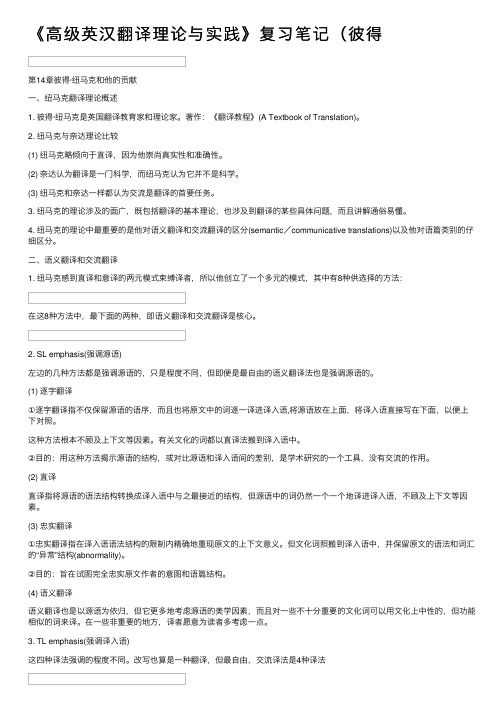
《⾼级英汉翻译理论与实践》复习笔记(彼得第14章彼得·纽马克和他的贡献⼀、纽马克翻译理论概述1. 彼得·纽马克是英国翻译教育家和理论家。
著作:《翻译教程》(A Textbook of Translation)。
2. 纽马克与奈达理论⽐较(1) 纽马克略倾向于直译,因为他崇尚真实性和准确性。
(2) 奈达认为翻译是⼀门科学,⽽纽马克认为它并不是科学。
(3) 纽马克和奈达⼀样都认为交流是翻译的⾸要任务。
3. 纽马克的理论涉及的⾯⼴,既包括翻译的基本理论,也涉及到翻译的某些具体问题,⽽且讲解通俗易懂。
4. 纽马克的理论中最重要的是他对语义翻译和交流翻译的区分(semantic/communicative translations)以及他对语篇类别的仔细区分。
⼆、语义翻译和交流翻译1. 纽马克感到直译和意译的两元模式束缚译者,所以他创⽴了⼀个多元的模式,其中有8种供选择的⽅法:在这8种⽅法中,最下⾯的两种,即语义翻译和交流翻译是核⼼。
2. SL emphasis(强调源语)左边的⼏种⽅法都是强调源语的,只是程度不同,但即便是最⾃由的语义翻译法也是强调源语的。
(1) 逐字翻译①逐字翻译指不仅保留源语的语序,⽽且也将原⽂中的词逐⼀译进译⼊语,将源语放在上⾯,将译⼊语直接写在下⾯,以便上下对照。
这种⽅法根本不顾及上下⽂等因素。
有关⽂化的词都以直译法搬到译⼊语中。
②⽬的:⽤这种⽅法揭⽰源语的结构,或对⽐源语和译⼊语间的差别,是学术研究的⼀个⼯具,没有交流的作⽤。
(2) 直译直译指将源语的语法结构转换成译⼊语中与之最接近的结构,但源语中的词仍然⼀个⼀个地译进译⼊语,不顾及上下⽂等因素。
(3) 忠实翻译①忠实翻译指在译⼊语语法结构的限制内精确地重现原⽂的上下⽂意义。
但⽂化词照搬到译⼊语中,并保留原⽂的语法和词汇的“异常”结构(abnormality)。
②⽬的:旨在试图完全忠实原⽂作者的意图和语篇结构。
纽马克的翻译理论 (课堂PPT)
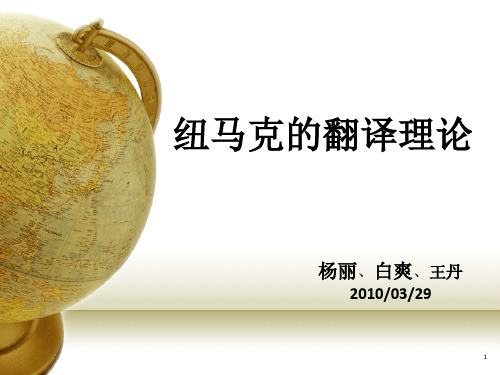
纽马克的翻译理论与归化异化 的比较
14
• 语义翻译应以作者为中心,重视作者的个性和权威, 译者不仅要传达文本的字面意义,而且还要尽可能 完整无损地表现文本的内涵意义、作者的写作风 格,以及表现手法等。文学类文本的翻译尤其应当 如此。因此,语义翻译的实质是异化。
15
• 纽马克强调交际翻译应以读者为中心,注重读者的 可能反应,重视读者的接受能力。由于读者认识的 局限,当异化的译本中出现的语言差异和文化障碍 读者无法跨越,甚至误解时,应以归化为策略导向。 所以,从这个意义上讲,交际翻译的实质是归化。
18
语义翻译与交际翻译的区别
语义翻译
交际翻
1 服从源语文化和源作者 • 忠于目标译语和目标文本
2 重内容不重效果
• 重效果不重内容
3
再现原文作者的思维过程,• 倾向于过译
采用与原文的语域一致 的语域,倾向于欠译
4
以较小的单词、短语或者 • 从句为翻译单位,译文短。
以段落为翻译单位,译 文长。
5 艺术
• 纽马克认为认知翻译是将原文文本从语法上转 换成“有生命主语+无生命宾语” 或其扩展句 型,即an agent(subject)+does(activeverb)something(direc t object) to or for someone (indirect object) with something (instrumental) somewhere(locative)some time (temporal) to make something(result),采取一系列手段消除 原文中的理解障碍,是原文变成一种普通的人 工性语言平面。
• 技巧
19
《翻译理论与翻译技巧》第一章 纽马克
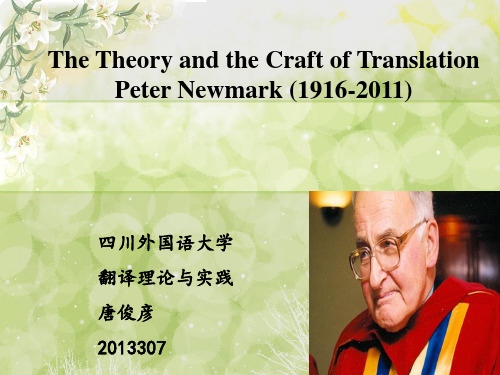
• 他的等值翻译理论又分为五个层次: • 1、lexical unit词汇单位 • 2、collocations词的搭配 • 3、information信息内容 • 4、situation情景场合 • 5、communication aim交际目的
• 寇勒(Koller)区分了信息和交际,而莱斯(Katharina Reiss)则分类说明了不同的原文种类等等。
translationpeternewmark19162011四川外国语大学翻译理论与实践唐俊彦2013307?一简介?二翻译和其他学科的关系?三翻译和意义上的走失?四翻译理论文献?五同语言功能有关的翻译理论?六翻译方法和技巧?七总结peternewmark19162011?著名的翻译家和翻译理论家?从事过多种欧洲语言的翻译工作是一位出色的译者和编辑?同时是一位语言学家并担任英国语言学家协会会长?英国萨里大学universitysurrey的教授?他的主要兴趣就是把语言学的相关理论应用于翻译实践之中把翻译研究和英语语言研究相结合?1981年纽马克的第一部著作翻译问题探索approachestranslation出版在这本书中他提出了语义翻译semantictranslation和交际翻译communicativetranslation的概念
五、同语言功能有关的翻译理论
• 纽马克认为,翻译活动即是对文本的翻译, 研究翻译不能离开文本。 • Newmark对原语文本的三种分类: 表达功能(expressive function) 信息功能(informative function) 呼唤功能(vocative function)
Newmark对原语文本的三种分类
• 康米萨罗夫(Komissarov)看到翻译理论正在向 三个方向发展: • 1、denotative (information translation information translation) • 外延方向(情报译法) • 2、semantic (precise equivalence) • 语义方向(确切等值译法) • 3、transformational( transposition of relevant structures) • 转换方向(相关结构换位译法)。
《纽马克翻译教程》课件

本课件旨在介绍《纽马克翻译教程》的内容和学习方法,分享翻译技巧,并 通过实例演示帮助学习者提升翻译水平。
介绍
背景
了解纽马克翻译教程的起源和发展,介绍该教程的作者和目标受众。
课程结构
概述教程的模块组成和内容安排,强调每个模块的重要性和学习收益。
教程内容
基础知识
学习语言学基础和翻译理论, 掌握翻译的核心概念和方法。
实践技巧
探索实用的翻译技巧和工具, 提高翻译效率和准确性。
领域专长
培养在特定领域的专业翻译技 能,理解和应用行业术语和惯 用语。
学习方法
1
自学
通过阅读课程材料和参考书籍,自主探索翻译技巧和最佳实践。
2
实践
通过参与实际翻译项目和模拟演练,提升翻译技能和应用能力。
3
互动
参加在线讨论和交流,与其他学习者分享经验和学习心得。
跨文化交流
探讨在翻译中面临的跨文化挑战 和如何进行有效的跨文化交流。
课程评价
学员口碑
分享学员对《纽马克翻译教程》的评价和体验, 展示学习成果和提升效果。
专业认证
介绍相关翻译认证考试和证书,提升学习者的职 业竞争力。
问题和讨论
留出时间回答学员的问题和与学员交流,提供互动的学习环境。
翻译技巧
1 语境理解
通过深入理解原文语境,准确传达作者意图和信息。
2 词汇选择
掌握各类词汇和短语的正确运用,提高翻译的准确性和专业性。
3 语体转换
根据目标受众和文体要求,在不失原意的前提下进行语体转换。
实例演示
翻译过程
通过实际案例演示翻译的步骤和 技巧,展示成功翻译的方法。
翻译工具
第四章-翻译方法-纽马克
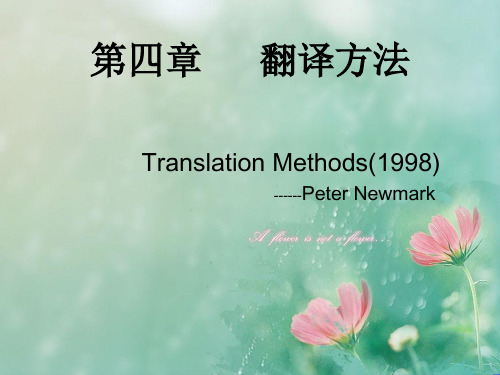
Introduction
Étienne Dolet Vladimir Nabokov William Tyndale John Wyclif Walter Benjamin
Étienne Dolet:
艾蒂安•多雷(1509-1546),文艺复兴时期欧洲法 国人文主义者。否认灵魂不朽(永生),被索邦神 学院的神学家处以火刑。
翻译单位和语篇分析 翻译与文化
Introduction
Burn at the stake:
原指中世纪的时候,异教徒在火刑柱上被烧 死。指极其严厉的惩罚。
Cultural Anthropology 文化人类学
即研究人类各民族创造的文化,以揭示人类文化 的本质;找出人类文化的特殊现象和通则性。
纽马克翻译教程

(三)交际翻译和语义翻译的比较
参数 翻译单位 翻译方法的性质 翻译侧重点 评价标准
文本类型
交际翻译 句子 cause or sentence 技巧 craft
语义翻译 词 word 艺术 art
信息message
意义meaning
目的语文本中传递原语文本信 原语文本重要性再现的准确性 息的准确性
非文学作品、新闻报道、公函、哲学、宗教、政治声明、科技
(四)主要作品
• 1988年,出版《翻译教程》(A Textbook of Translation),该 书后1988年英国应用语言学协会奖。
• 1991年,出版《论翻译》(About Translation)一书,提出全 新概念“翻译关联法”。
• 分别于1993年何1995年,又出版了《翻译短评》(Paragraphs on Translation)和《翻译短评(第二集)》(More paragraphs on Translation)。其中前两本书被翻译成多种语言,且多次版 印,影响深远,奠定了纽马克在英国翻译界的地位。
• 语义翻译则力争表现原文确切的语义,译文应尽可能接近原文的词汇结构和语法结 构。
• (二)Sematic translation 语义翻译
• 语义翻译强调的是原文信息的传递,它更倾向于以原作和源语文化为基础,力求在 最大程度上展现原作的味道,这种方法指导下翻译出来的作品更加忠实于原文。
• 例如:在翻译文学作品中,从传播中华文化的角度来说,可采用语义翻译。
一、纽马克个人简介
• (四)主要作品
上个世纪60年代末,翻译这项语言活动开始引起广泛的关注。特别是语言 学的相关理论介入后,翻译研究取得了很大成果。1974年,纽马克升任教授, 开设翻译理论课。从这时起,纽马克开始写一些专门论述翻译问题的文章。 在大量的翻译实践和教学实践的指引下,纽马克的翻译思想开始初具形态。 正如纽马克自己所言他的大多数想法都是来自课堂。1981年,纽马克的第一 部著作《翻译问题探讨》出版,立刻引起广泛赞誉。正是在这本书中,他提 出了“语义翻译”和“交际翻译”的概念。
简述纽马克的语义翻译和交际翻译及其对汉英语篇翻译的影响
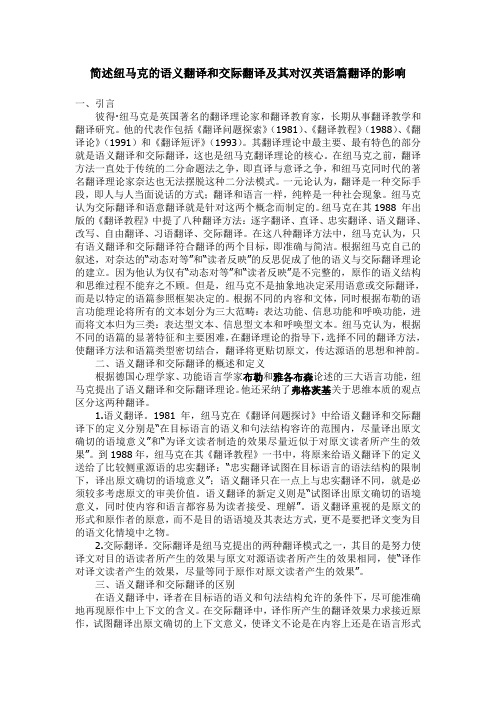
简述纽马克的语义翻译和交际翻译及其对汉英语篇翻译的影响一、引言彼得·纽马克是英国著名的翻译理论家和翻译教育家,长期从事翻译教学和翻译研究。
他的代表作包括《翻译问题探索》(1981)、《翻译教程》(1988)、《翻译论》(1991)和《翻译短评》(1993)。
其翻译理论中最主要、最有特色的部分就是语义翻译和交际翻译,这也是纽马克翻译理论的核心。
在纽马克之前,翻译方法一直处于传统的二分命题法之争,即直译与意译之争,和纽马克同时代的著名翻译理论家奈达也无法摆脱这种二分法模式。
一元论认为,翻译是一种交际手段,即人与人当面说话的方式;翻译和语言一样,纯粹是一种社会现象。
纽马克认为交际翻译和语意翻译就是针对这两个概念而制定的。
纽马克在其1988 年出版的《翻译教程》中提了八种翻译方法:逐字翻译、直译、忠实翻译、语义翻译、改写、自由翻译、习语翻译、交际翻译。
在这八种翻译方法中,纽马克认为,只有语义翻译和交际翻译符合翻译的两个目标,即准确与简洁。
根据纽马克自己的叙述,对奈达的“动态对等”和“读者反映”的反思促成了他的语义与交际翻译理论的建立。
因为他认为仅有“动态对等”和“读者反映”是不完整的,原作的语义结构和思维过程不能弃之不顾。
但是,纽马克不是抽象地决定采用语意或交际翻译,而是以特定的语篇参照框架决定的。
根据不同的内容和文体,同时根据布勒的语言功能理论将所有的文本划分为三大范畴:表达功能、信息功能和呼唤功能,进而将文本归为三类:表达型文本、信息型文本和呼唤型文本。
纽马克认为,根据不同的语篇的显著特征和主要困难,在翻译理论的指导下,选择不同的翻译方法,使翻译方法和语篇类型密切结合,翻译将更贴切原文,传达源语的思想和神韵。
二、语义翻译和交际翻译的概述和定义根据德国心理学家、功能语言学家布勒和雅各布森论述的三大语言功能,纽马克提出了语义翻译和交际翻译理论。
他还采纳了弗格茨基关于思维本质的观点区分这两种翻译。
纽马克语义翻译与交际翻译.ppt
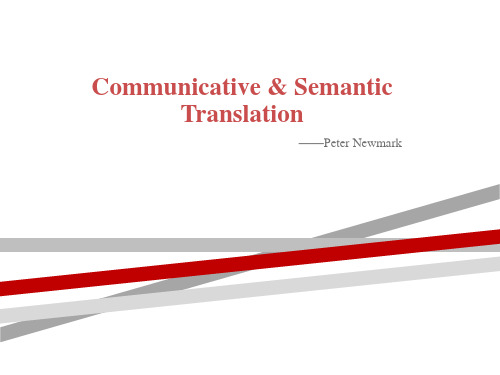
Form of Target Language
ST : more complex, more awkward, more detailed, more concentrated, it tends to overtranslate CT: smoother, simpler, clearer, more direct, more conventional, conforming to a particular register of language, tending to undertranslate
Semantic translation attempts to render, as closely as the semantic and syntactic structures of the second language allow, the exact contextual meaning of the original.
Through the Looking-Glass 《爱丽丝镜中奇遇记》
“Feather, I say!” “Why do you say ‘Feather’ so often?” Alice asked at last, rather vexed. “I’m not a bird!” “You are,” said the sheep: “you are a little goose” CT:“ 撇桨呀,我说!”阿丽思有点儿觉得她频气了, 她就说,“你干嘛老说‘别讲’啊?我也没讲 啊!”“什么没桨!”那绵羊说,“你手里摇的是什 么,你简直是个笨猪。” (赵元任) ST:“ 我说,羽毛!”“为什么你老是说‘羽毛’?” 爱丽丝觉得烦了,终于问道,“我又不是禽 鸟!”“你是禽鸟,”绵羊说,“你是只小 鹅。”(王永年)
纽马克的翻译理论

纽马克的翻译理论Chapter 2Peter NewmarkSemantic and Communicative Translation Guided Reading Peter Newmark (1916) is an accomplished translation scholar as well as an experienced translator. He has translated a number of books and articles and published extaensively on translation. His publications on translation include Approaches to Translation (1981), About Translation(1983), Paragraphs on Translation段落翻译(1985), A Textbook of Translation翻译教程(1988), and More Paragraphs on Translation(1993).In his work Approaches to Translation, Newmark proposes two types of translation: semantic translation语义翻译and communicative translation交际翻译. Semantic translation focuses primarily upon the semantic content of the source text whereas communicative translation focuses essentially upon the comprehension and response of receptors. This distinction results from his disapproval of Nida's assumption假定,假设,设想;假装;承担,担任that all translating is communicating, and the overriding最主要的,最优先的principle of any translation is to achieve "equivalent effect". For Newmark, the success of equivalent effect is "illusory", and that "the conflictof loyalties, the gap between emphasis on source and target languages will always remain as the overriding problem in translation theory and practice"(1981:38). To narrow the gap, Newmark 系统地阐述,确切地表达;规划,构想出formulates his concepts of "communicative translation" and "semantic translation", which in a sense从某种意义上说are similar to Nida's "dynamic equivalent translation" and "formal equivalenttranslation". Newmarks admits "communicative translation" is a common method and could be used in many types of translation. Nevertheless, he justifies证明……正当/有理,为……辩护the legitimacy合法性,正当;合理性,妥当;嫡出,正统of "semantic translation" in the following three aspects. Firstly, all translations depend on the three 一分为二,二分法;本质对立dichotomies, namely, the foreign and native cultures, the two languages, the writer and the translator. Hence, it is unlikely to have a universal theory that could include all these factors. Secondly, previous discussions on methods of translation, either Nida's "dynamic equivalence" or Nabokow's "literal translation", does not reflect the actual reality of translation method, for each of them either recommends one or 贬低,轻视disparages the other. Thirdly, the social factors, especially the readers of the second language, only play a partial部分的;偏爱/袒/心的role发挥部分作用in translation. Some texts, such as an expressive one, require a "semantic translation"(1981:62). It can be seen that 可以看出by proposing the coexistence of "communicative translation" and "semantic translation", Newmark suggests a correlation相互关系,关联;相关性between translation method and text type.It should be pointed out that应该指出的是Newmark's semantic translation differs from literal translation直译because the former "respects context", interprets and even explains while the latter sticks very closely to source text at word and syntax level(1981:62). Literal translation, however, is held to be the best approach in both semantic and communicative translation, "provided that如果equivalent effect is secured, the literal word-for-word translation is not only the best, it is the only valid method of translation"(1981:39). Here Newmark seems to onlytake account of考虑到,顾及,体谅literary translation rather than non-literary translation, which is often rendered more freely in order to communicate the meaning. But he also states that when there is a conflict between semantic and communicative translation, the latter would win out胜出. For instance, it is better to render communicatively the public sign 公共标志bissiger Hund and chien mechant into beward thedog! in order to communicate efficiently the message, but not semantically as dog that bites! and bad dog!(1981:39). Nevertheless, it is difficult for a translator to follow Newmark's translation methods in practice, which should be adopted flexibly according to the specific context and text type.A Textbook of Translation is an expansion and a revision of Approaches to Translation in many aspects在很多方面. In this book, Newmark, follwing the German linguist Karl Buhler's functional theory of language, proposes three main types of texts (i.e. expressive有表现力的,富有表情的, informative提供大量资料或信息的,授予知识的and vocative呼格的) as well as methods of translating them (Chapters 4 and 5). Although he lists many translation methods from word-for-word translation to adaptation, he insists that "only semantic and communicative translation fulfill the two main aims of translation, which are first, accuracy, and second, economy". While semantic translation is used for expressive texts, communicative translation is for informative and vocative texts although he admits that few texts are purely expressive, informative or vocative. By stressing the wide applicability of these two translation methods, Newmark seems to overlook the function of other translation methods frequently adopted in translationpractice.Newmark's semantic and communicative translation ahve been quoted frequently among translation scholars. His concern about the coexistence of semantic and communicative translation shows that in his view effect-oriented translation以效果为导向的翻译such as Nida's dynamic equivalence should not be overstressed in translation practice, but is just one type of translation. Newmark's types of translation, however, are less influential than Nida's dynamic equivalence in the field of translation studies because they "raise some of the same points concerning the translation process and the importance of the TT reader译文读者" (Munday 2000:46). Further, his views and comments are still very traditional and prescriptive规定的,指定的,规范的, bearing some traces of traditional translation theories. The strength of his writing lies in that his discussion on translation covers a wide range of topics, and he always provides useful advice and guidance for translator 接受训练的人,实习生,培训生trainees with a large number of interesting and useful examples, which are more convincing than abstract theoretical arguments抽象的理论论证. The following excerpt is selected from Chapter 3 of Newmark's Approaches to Translation. In this chapter he 假定,要求postulates his twomain methods of translation (i.e. Semantic and communicative translation), and tries to apply them into different types of text. Communicative and Semantic Translation1.A translation must give the words of the original.2.A translation must give the ideas of the original.3.A translation should read like an original work.4.A translation should read like a translation.5.A translation should reflect the style of the original.6.A translation should possess the style of the translation.7.A translation should read as a contemporary of the original.8.A translation should read as a contemporary of the translation.9.A translation may add to or omit from the original.10.A translation may never add to or omit from the original.11.A translation of verse should be in prose.12.A translation of verse should be in verse.(The Air of Translation, T.H. Savory, Cape, 1968, p.54)In the pre-linguistics period of writing on translation, which may be said to date from Cicero through St. Jerome, Luther, Dryden, Tytler, Herder, Goethe, Schleiermacher, Buber, Ortega y Gasset, not to say Savory, opinion swung between literal and free, faithful and beautiful, exact and natural translation, depending on whether the bias was to be in favour of赞成the author or the reader, the source or the target language of the text. Up to the nineteenth century, literal translation represented a philological语言学的,文献的,文学的academic exercise语言学学术活动from which the cultural reformers文化改革者were trying to rescue literature. In the nineteenth century, a more scientific approach was brought to bear on对……有影响,和……有关translation, suggesting that certain types of texts must be accurately translated, while others should and could not be translated at all! Since the rise of modern linguistics (philology语言学was becoming linguistics语言学here in the late fifties), and anticipated by预计到Tytler in 1790, Larbaud, Belloc, Knox and Rieu, the general emphasis, supported by communication-theorists as well as by non-literary translators, has been placed on the reader---on informing the reader effectively and appropriately, notably显著地,明显地;尤其,特别in Nida, Firth, Koller and the Leipzig School. In contrast 相反, the brilliant essaysof Benjamin, Valery and Nabokov (anticipated by Croce and Ortega y Gasset) advocating literal translation have appeared as isolated孤立的,被隔离的, paradoxical phenomena自相矛盾的现象, relevant only to 与……有关translating works of high literary culture. Koller (1972) has stated that the equivalent-effect principle of。
- 1、下载文档前请自行甄别文档内容的完整性,平台不提供额外的编辑、内容补充、找答案等附加服务。
- 2、"仅部分预览"的文档,不可在线预览部分如存在完整性等问题,可反馈申请退款(可完整预览的文档不适用该条件!)。
- 3、如文档侵犯您的权益,请联系客服反馈,我们会尽快为您处理(人工客服工作时间:9:00-18:30)。
Communicative and semantic translation (I)1. A translation must give the words of the original.2. A translation must give the idea of the original.3. A translation should read like an original work.4. A translation should read like a translation.5. A translation should reflect the style of the original.6. A translation should possess the style of the translation.7. A translation should read as a contemporary of the original.8. A translation should read as a contemporary of the translation.9. A translation may add to or omit from the original.10. A translation may never add to or omit from the original.11. A translation of verse should be in prose.12. A translation of verse should be in verse.(The Art of Translation, T H. Savory, Cape, 1968, p 54.) In the pre-linguistic period of writing on translation, which may be said to date from Cicero through St. Jerome, Luther, Dryden, Tytler, Herder, Goethe, Schleiermacher, Buber, Ortegay Gosset, not to say Savory, opinion swung between literal and free, faithful and beautiful, exact and natural translation, depending on whether the bias was to be in favor of the author or the reader, the source or the target language of the text. Up to the nineteenth century, literal translation represented a philological academic exercise from which the cultural reformers were trying to rescue literature. In the nineteenth century, a more scientific approach was brought to bear on translation, suggesting that certain types of texts must be accurately translated, whilst others should and could not be translated at all! Since the rise of modern linguistics (philology was becoming linguistics here in the late fifties), and anticipated by Tytler in 1790, Larbaud, Belloc, Knox and Rieu, the general emphasis, supported by communication-theorists as well as by non-literary translators, has been placed on the reader -- on informing the reader effectively and appropriately, notably in Nida, Firth, Koller and the Leipzig School. In contrast, the brilliant essays of Benjamin, Valery and Nabokov (anticipated by Croce and Ortegay Gasset) advocating literal translation have appeared as isolated, paradoxical phenomena, relevant only to translatingworks of high literary culture. Koller (1972) has stated that the equivalent-effect principle of translation is tending to rule out all others, particularly the predominance of any formal elements such as word or structure.The apparent triumph of the 'consumer' is, I think, illusory. The conflict of loyalties. the gap between emphasis on source and target language will always remain as theoverriding problem in translation theory and practice.However, the gap could perhaps be narrowed if the previous terms were replaced as follows:SOURCE LANGUAGE BIAS TARGET LANGUAGE BIASLITERAL FREEFAITHFUL IDOMATICSEMANTIC/COMMUNICATIVE(Figure 6)*** ***Communicative translation attempts to produce on its readers an effect as close as possible to that obtained on the readers of the original. Semantic translation attempts to render, as closely as the semantic and syntactic structures of the second language allow, the exact contextual meaning of the original.In theory, there are wide differences between the two methods. Communicative translation addresses itself solely to the second reader, who does not anticipate difficulties or obscurities, and would expect a generous transfer of foreign elements into his own culture as well as his language where necessary. But even here the translator still has to respect and work on the form of the source language text as the only material basis for his work. Semantic translation remains within the original culture and assists the reader only in its connotations if they constitute the essential human (non-ethnic) message of the text. One basic difference between the two methods is that where there is a conflict, the communicative must emphasize the 'force' rather than the content of the message. Thus for Bissiger Hund or Chien méchant, the communicative translation Beware of the dog! is mandatory; the semantic translations ('dog that bites', 'savage dog') would be more informative but less effective. Generally, a communicative translation is likely to be smoother, simpler, clearer, more direct, more conventional, conforming to a particular register of language, tending to undertranslate, i.e. to use more generic, hold-all terms in difficult passages. A semantic translation tends to be more complex, more awkward, more detailed, more concentrated, and pursues the thought-processes rather than the intention of the transmitter. It tends to overtranslate, to be more specific than the original, to include more meanings in its search for one nuance of meaning. However, in communicative as in semantic translation, provided that equivalent- effect is secured, the literal word-for-word translation is not only the best, it is the only valid method of translation. There is no excuse for unnecessary 'synonyms', let alone paraphrases, in any type of translation.Conversely, both semantic and communicative translation comply with the usually accepted syntactic equivalents (Vinay and Darbelnet's ‘transpositions') for the two languages in question. Thus, by both methods, a sentence such as 'll traversa la Manche en nageant' would normally be translated as 'He swam across the Channel'. In semantic, but not communicative translation, any deviation from SL stylistic norms would be reflected in an equally wide deviation from the TL norms, but where such norms clash, the deviations are not easy to formulate, and the translator has to show a certain tension between the writer's manner and the compulsions of the target language, Thus when the writer uses long complex sentences in a language where the sentence in a 'literary' (carefully worked) style is usually complex and longer than in the TL, the translator may reduce the sentences somewhat, compromising between the norms of the two languages and the writer. If in doubt, however, he should trust the writer, not the “language', which is a sum of abstractions. A semantic translation is concrete. Thus when faced with:'Der Gesichtspunkt der Nützlichkeit ist gerade in Bezug auf ein solches heißesHerausquellen oberster rang-ordnender, rang-abhebender Werturteile so fremdund unangemessen wie möglich;hier ist eben das Gefühl bei einem Gegensatze jenes niedrigen Wärmegrades angelangt, den jede berechnende Klugheit, jederNützlichkeit-Kalkul voraussetzt'(Zur Genealogie der Moral (2) Nietzsche)the translator has to cling to words, collocations, structures, emphases:"The utilitarian point of view is as alien and inappropriate as it possibly could be precisely to such an intense eruption of supreme rank-classifying, rank- discriminating value-judgments: here in fact feeling has reached the antithesis of the low degree of fervour presumed in every type of calculating cleverness, every assessment of utility ' (My version.)Thus a translation is always closer to the original than any intralingua] rendering or paraphrase misnamed 'translation" by George Steiner (1975), and therefore it is an indispensable tool for a semantician and now a philosopher. Communicative and semantic translation may well coincide -- in particular, where the text conveys a general rather than a culturally (temporally and spatially) bound message and where the matter is as important as the manner -- notably then in the translation of the most important religious, philosophical, artistic and scientific texts, assuming second readers as informed and interested as the first. Further, there are often sections in one text that must be translated communicatively (e.g. non-lieu -- 'nonsuit'), and others semantically (e.g. a quotation from a speech). There is no one communicative nor one semantic method of translating a text -- these are in fact widely overlapping bands of methods. A translation can be more, or less, semantic -- more, or less, communicative-- even a particular section or sentence can be treated more communicatively or less semantically. Thus in some passages, Q. Hoare and G. Nowell Smith (1971) state that:'we feel it preferable to choose fidelity over good English, despite its awkwardness, in view of the importance of some concepts in Gramsci's work.' Each method has a common basis in analytical or cognitive translation which is built up both proposition by proposition and word by word, denoting the empirical factual knowledge of the text, bin finally respecting the convention of the target language provided that the thought-content of the text has been reproduced. The translation emerges in such a way that the exact meaning or function of tile words only become apparent as they are used. The translator may have to make interim decisions without being able at the time to visualize the relation of the words with the end product. Communicative and semantic translation bifurcate at a later stage of analytical or cognitive translation, which is a pre-translation procedure which may be performed on the source-language text to convert it into the source or the target language – the resultant versions will be closer to each other than the original text and the final translation.*** ***In principle, cognitive translation transposes the SL text grammatically to plain 'animate subject + verb + non-animate object' clauses, or, in the extended version, to sequences of: 'an agent (subject) does (active verb) something (direct object) to or for someone (indirect object) with something (instrumental) somewhere (locative) sometime (temporal) to make something {resultant}' -- additionally, an agent/object may be in a variety of relationships with another agent/object (possessive, equative, dependency, source, partitive, genitive, characteristic, etc) -- (relationships often covered or concealed by tile English preposition 'of'), which must be spelt out in a clause. Thus the grammatical meaning of the SL text becomes explicit. Further, cognitive translation splits up the word-class derivatives, i.e. adverbs (= preposition + adjective + noun), adjectival nouns (e.g. 'whiteness'). qualifying prefix-verb-nouns (e.g. 'contribution'), noun-verbs (e.g. 'to ration'), noun-adjective-verb-nouns (e.g. 'rationalization’), etc., into their components and explicates the relations of all multiple noun compounds (e.g. ‘data acquisition control system': system to control the acquiring of data). Further, it replaces figurative and colloquial language, idioms and phrasal verbs with denotative terms; clears up lexical and grammatical ambiguities; interpolates relevant encyclopaedic information for ecological, cultural and institutional terms; replaces pronouns with nouns and identifies referential synonyms; reduces cultural terms to their functional definitions; and analyses the semantic features of any words that are likely to be split into two or three words when translated. Thus as far as is possible (the process is artificial) the text is removed from its natural cultural and linguistic axis to an artificial neutral universal plane of language.Nida in his admirable analysis of grammatical meaning (1974a. pp. 47-49) approaches cognitive translation somewhat differently, preferring to split surface structures into separate underlying (previously concealed) sentences. Thus he analyses: 'their formerdirector thought their journey was a deception' into: (a) he directed them formerly, (b) he thought X (the entire following expression), (c) they journeyed, (d) they deceived Y (without specifying who Y is), adding an analysis of the relationship between (c) and (d)--e.g. means-result: by journeying they deceived', means-purpose (they journeyed in order to deceive), additive events (they journeyed and they deceived).For cognitive translation, I think: 'The man who used to be their director (to direct them) thought they had traveled to deceive (by traveling they had deceived, they had traveled and deceived)' is adequate. Another (more likely?) alternative missed by Nida must be added: 'Tile man who used to be their director thought they had merely pretended to travel, m order to deceive others.' (Most verbal nouns may be active or passive in meaning.)It is not usually necessary to make a full cognitive translation, a procedure similar to Brislin's (1976) 'decentring'. Where the cultures of two languages have been in contact for centuries, the translator normally resorts to cognitive translation only for obscure, ambiguous or complex passages. A cognitive translation may serve as a tertium comparationis between texts with distant cultures and radically different language structures.*** ***Where cognitive translation results in a poorly written and/or repetitive text, communicative translation requires a bold attempt to clarify and reorganize it. A text such as the followinng would require considerable rewriting before it is translated:'If industrialists are so keen for Britain to join why does not the Governmentmake it possible for those who want to get into Europe without the sacrificeto British sovereignty … which must be the inevitable result of ourjoining if we are to rely on M. Debre's words recently that the CommonMarket is unworkable without the Treaty of Rome.'(The Times, 18 July 1961, quoted in The Use of English, R. Quirk, Longmans, 1964.)Proposed rewrite:'As industrialists are so keen, why does not the Government make it possible for Britain to get into Europe without sacrificing her sovereignty? According to M. Debré's recent statement, this would first require amendments to the Treaty of Rome, which is the legal instrument governing the Common Market.'I am assuming that whilst a semantic translation is always inferior to its original, since it involves loss of meaning, a communicative translation may be better, since it may gain in force and clarity what it loses in semantic content. In communicative translation the translator is trying in his own language to write a little better than theoriginal, unless he is reproducing the well-established formulae of notices or correspondence. I assume that in communicative translation one has the right to correct or improve the logic; to replace clumsy with elegant, or at least functional, syntactic structures; to remove obscurities; to eliminate repetition and tautology; to exclude the less likely interpretations of an ambiguity; to modify and clarify jargon (i.e. reduce loose generic terms to rather more concrete components), and to normalize bizarreries of idiolect, i.e. wayward uses of language. Further, one has the right to correct mistakes of fact and slips, normally stating what one has done in a footnote. (All such corrections and improvements are usually inadmissible in semantic translation.)In theory a communicative translation is ipso facto a subjective procedure, since it is intended primarily to achieve a certain effect on its readers' minds, which effect could only be verified by a survey of their mental and/or physical reactions. In fact, it is initially as constrained by the form, the structures and words of the original as a semantic translation (the pre-translation process) until the version is gradually skewed to the reader's point of view. Then the translator starts to ask himself whether his version is 'happy', i.e. a successful 'act', rather than whether it is true, i.e. an exact statement (cf. Austin, 1962). He begins to extend the unit of translation, having secured the referential basis, i.e. the truth of the information; he views words and phrases in expanding waves in their linguistic context, restructuring or rearranging clauses, reinforcing emphases. Nevertheless, each lexical and grammatical unit bas to remain accounted for -- that is his Antaean link with the text.*** ***In one sense, communicative translation, by adapting and making the thought and cultural content of the original more accessible to the reader, gives semantic translation another dimension. The Leipzig School, notably Neubert and Kade, have referred to this as the 'pragmatic' elenient, but I think this is a little misleading. To begin with, Peirce and notably Morris defined 'pragmatics' as the branch of semiotics that deals with the relation between signs or linguistic expressions and their users (transmitters and receptors). Communicative translation, however, is concerned mainly with the receptors, usually in the context of a language and cultural variety, whilst semantic translation is concerned with the transmitter usually as an individual and often in contradistinction both to his culture and to the norms of his language. Moreover 'pragmatic' is a confusing term, since even in the context of translation (let alone its abundant senses in philosophy) it is also used in the sense of 'nonliterary', 'technical' and 'practical'. Neubert and Kade have maintained that the pragmatic (in the semiotic sense) is the variant, difficult and often ‘'untranslatable’ element in translation, whilst the cognitive (the material basis and environment) is invariant, relatively easy and always translatable. Whilst this view obviously has some truth {the objective, physical and concrete being on the whole easier to translate than the subjective, mental and figurative}, it ignores the indisputable proportion of truth inthe Humboldt thesis {the weak thesis} that each language has its own distinctive structure, reflecting and conditioning the ways of thought and expression of the people using it, but for which translation would be an easy business. Further, this view hardly comes Io terms with the fact that most material objects derive their names from the result of mental analogies and comparisons, that is, from metaphor, not from any scientific made-to-measure neologisms, and that all languages are wilful and different in their naming of some of the commonest physical objects. Lyons (1976) and Weightman (1967) have independently shown how inadequate or overloaded would be any translation into French of the apparently simple, observational, objective. non-'pragmatic' sentence 'The cat sat on the mat'. Both the French version (possibly, 'Le chat était accroupi sur le paillasson') and the rather better German version ('Die Katze hockte auf der Fuβdecke') are overtranslations, illustrating French and German's lack of words of sufficient generality and consequently of equivalent frequency. On the other hand, there are many cases where the 'pragmatic' element can be translated without difficulty, provided the viewpoint represented in the SL culture is well understood by the reader of the translation: thus words like 'revisionist', 'terrorist', 'patriotic', 'proletarian', 'formalistic', etc., can be 'agreed' according to the national culture in the educated writing of many world-languages. A GDR term such as Abgrenzen (refusal to compromise with non-socialist policies), though it is a pragmatic 'hot potato', can usually be safely translated without any of the three points of view (the transmitter's, the receptor's, the translator's) obtruding on the message. For Jäger (1975), the 'pragmatic element' is what transforms a 'semantic' (i.e. cognitive) into a ‘functional’ (i.e. communicative) translation -- like most of the linguistic theorists, he only accepts the validity of communicative (his 'functional') translation and implicitly downgrades semantic translation.*** ***I would prefer to avoid the use of the term 'pragmatic' and to regard both communicative and semantic as divergent refinements or revisions of cognitive translation. In both cases, the cognitive element may soon have to be abandoned, since the TL view of the same referent (object or message) may differ from the SL (cf. château d’eau – ‘water tower’; pas de danger – ‘not likely!’). The transition to semantic translation normally reduces the unit of translation, and brings the text closer to the figurative and formal elements of the original, including where possible its sound effects. Therefore the text becomes more idiosyncratic and ‘sensitive’. Length of sentences, however long or short, position and integrity of clauses, word-position for emphasis, are preserved, unless the divergence between the relevant norms of the source and target languages (which also have to be considered, although the individual writer’s ‘style’ finally prevails) is extensive. The transition to communicative translation normally makes the text smoother, lighter, more idiomatic and easier to read. Syntax is remodeled, commoner collocations and more usual words are found. Semantic translation is basically addressed to one ‘reader’ only, namely, thewriter of the SL text, with the assumption that he can read the TL and will be the best arbiter of the translation’s quality.*** ***Since the overriding factor in deciding how to translate is the intrinsic importance of every semantic unit in the text, it follows that the vast majority of texts require communicative rather than semantic translation. Most non-literary writing, journalism, informative articles and books, textbooks, reports, scientific and technological writing, non-personal correspondence, propaganda, publicity, public notices, standardized writing, popular fiction – the run-of-the-mill texts which have to be translated today but were not translated and in most cases did not exist a hundred years ago – comprise typical material suitable for communicative translation. On the other hand, original expression, where it is philosophical, religious, political, scientific, technical or literary, needs to be translated semantically. Any important statement requires a version as close to the original lexical and grammatical structures as is obtainable. Thus Spears’ (1966) translation of the following passages of De Gaulle’s 18 June 1940 broadcast is unacceptable:‘Infiniment plus que leur nombre, ce sont les chars, les avions, la tactiquedes Allemands qui nous font reculer. Ce sont les chars, les avions, la tactiquedes Allemands qui ont surpris nos chefs au point de oes amener là ou ils ensont aujourd’hui … ’‘It was the tanks, the planes and the tactics of the Germans, far more thanthe fact that we were outnumbered, that forced our armies to retreat. Itwas the German tanks, planes and tactics that provided the element ofsurprise which brought our leaders to their present plight.’(Suggested version:‘Far, far more than their numbers, it was the tanks, the planes and the tacticsof the Germans that caused us to retreat. It was the tanks, the planes andthe tactics of the Germans that took our leaders by surprise and thusbrought them to the state they are in today.’)‘Car la France n’est pas seule! Elle n’est pas seule! Elle n’est pas seule!’‘For remember this, France does not stand alone. She is not isolated.’ (Suggested version:‘For France is not alone! She is not alone! She is not alone!’)In these and other passages, Spears has attempted to modify the starkness, simplicity and rawness of De Gaulle's speech. (As a communicative translation of a narrative, Spears's first paragraph is valid, but the translation of quotations, however unimportant, is normally semantic rather than communicative, since the translator is not responsible for their effect on the second reader.)Autobiography, private correspondence, any personal effusion requires semantic treatment, since the 'intimate' flavor of the original is more important than its effect on the reader.One would normally expect to translate serious literature (high art) semantically, but one has to bear in mind that all art is to a greater or lesser extent allegorical, figurative, metaphorical and a parable, and therefore has a communicative purpose. Figurative language only becomes meaningful, if it is recreated in the metaphors of the target language and its culture, or, if this is not possible, reduced to its sense. In the case of minor literature that is closely bound to its period and its culture (short stories in particular), semantic translation will attempt to preserve its local flavor -- dialect, slang and cultural terms (mots-témoins) will present their own problems. In the case of works with universal themes (e.g. love lyrics) and a background that is similar for SL and TL (say, in ecology and living conditions), there is no reason why a basically semantic translation should not also be strongly communicative. Bible translation should be both semantic and communicative, although the 'modern' preference (Schwarz, 1970) for ‘philological’ as opposed to ‘inspirational’ translation has for long moved away from studies which regarded the text as inspired and untouchable. Nida has shown in his many books that the TL reader can only accept the geographical and historical remoteness of the cultural background being presented to him, if that behavior itself and all imagery connected with it is recast in his own (modern) culture. In fact, as the myths recede and less knowledge can he expected from modern man, each new translation of the Bible becomes more communicative, with the omission of technical terms, dialect and slang, and directed at increasing numbers of less-well-read people. Again, the immediate communicative importance of drama is usually greater than that of poetry or of serious fiction, and for this reason adaptations (where characters and milieu are transferred) are sometimes made, whilst they are almost unknown in the novel. However, in the most concentrated drama (Shakespeare, Chekhov) the essence of which is that words are packed or charged with meaning, semantic takes precedence over communicative equivalence, since the translator assumes that the dramatist has made use of his inventive resources to give his language communicative potential; it is now the translator’s task to extract the utmost semantic equivalence from the original. Again, where the medium (i.e. the form) is as important as the message, and the peoples of the two language cultures can normally say the same things using different words, the two elements fuse.It is not always possible to state which is the better method to use for a particular text. In a mainly informative text, the section containing recommendations, instructions,value-judgments, etc. may be translated more communicatively than the descriptive passages. Where language is used to accompany action or as its symbol (speech-acts),it is treated communicatively, whilst definitions, explanations, etc. are semantic. ‘Standardized language’ must always be translated communicatively, whether a standardized equivalent exists or not, even if it appears in a novel or a quotation, unless the term is used descriptively rather than operatively in the original text. Normally in communicative translation it is assumed that the readers of the translation identify with those of the original. However, this is unlikely when elements of the source language culture or of the source language itself are discussed in the text. Nevertheless, ‘communication’ is as important here as in a text where the subject-matter is of general interest. Where, say, an institution of the SL community is being described, a special meaning of a SL word is used or the double meaning of a homophone or homonym is being exploited, the translator, if he thinks the point sufficiently important, has to render the author’s message communicatively and also address himself independently to the TL reader; in short, he has to ‘make’ the pun as well as explain it. He has to assess (a) the extent of his reader’s knowledge of and interest in the relevant aspect of the source language or culture, (b) the text’s level of specialism. If he is writing for the general reader, he may be able to achieve his purpose by transcribing the appropriate new SL terms unlikely to be familiar to his reader and adding their approximate cultural equivalents (e.g. Fachhochschule or ‘polytechnic’). If the terms are not likely to recur, he may decide not to transcribe them. If the text is specialized, the translator may wish to give his reader all possible information, including the transcription, the cultural equivalent, the encyclopedic definition within the source culture and the literal translation of any new term on the first occasion of its use. He may even propose a ‘translation label’, i.e. a word used ina new sense, provided he states that he is doing so, and he believes the object or concept is likely to recur in the TL usage. (Thus Volksrat, second chamber, regional assembly in GDR, cf. Bundesrat in FRG, People’s Council, National Council.) Or again, if ‘Flying planes can be dangerous’ is to be translated, the double meaning hasto be explained in the TL with SL illustrations. All that is lost is vividness. Finally, whilst ambiguity, polysemy, word-play, etc. in literary works have to be reproduced as best they can in the TL only (in poetry and plays it is a ‘hit or miss’ procedure – in prose fiction there s room for brief expansion), such facts of language when discussedin non-literary works (e.g. on language, criticism, psychology) must be fully reproduced in the SL and explained in the TL. This has been superbly done by James Strachey in his translation of Freud’s Jokes and their Relation to the Unconscious (1975) (his introduction contains valuable comments). The book had been previously translated by A. A. Brill as Wit and Its Relation to the Unconscious and many examples of word-play replaced by analogous English ‘equivalents’, a spurious procedure, since the translator gave no evidence of any patient ever having made such word-slips or puns in English.In the following passage on therapeutic methods in rheumatology, ‘La mobilisation。
